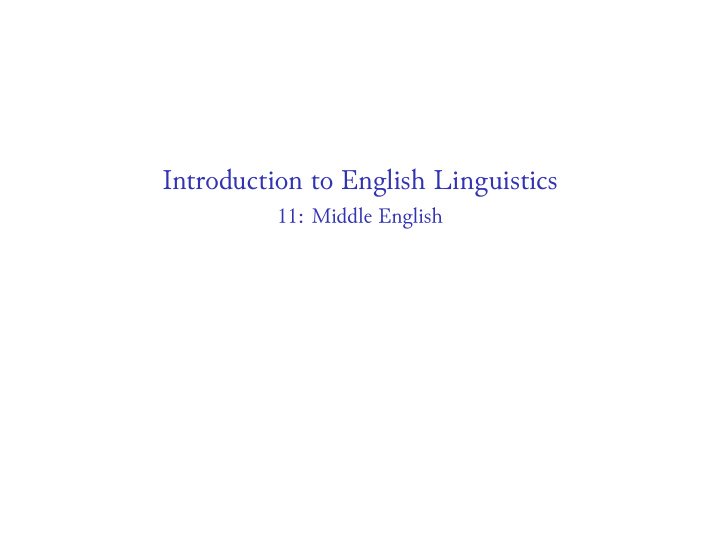



Introduction to English Linguistics 11: Middle English
For Next Week books.google.com/ngrams
Inflectional Levelling Old English Middle English hȳran hēren wē hȳraþ wē hēren þæt wē hȳren þat wē hēren þā dagas þē daies þāra daga of þē daies þām dagum in þē daies
Nouns Masc OE sg ME sg OE pl ME pl Nom stān stōn(e) stānas stōnes Acc stān stōn(e) stānas stōnes Gen stānes stōnes stāna stōnes Dat stāne stōn(e) stānum stōnes
Gender OE grammatical gender → ME natural gender ▶ OE demonstrative se , seo , þæt > ME article þe / the ▶ Largely grammatical OE hē , hēo , hit > largely natural ME he , she , it OE þæs mægdnes mod ME þe maidens erand ME In to boure he was ladde, þe maiden for to se; he fond hir liggeand on hir bedde.
Verbs Present Indicative Person OE sg ME sg OE pl ME pl 1 secge seie secgað seien 2 sægst seiest secgað seien 3 segð seieth secgað seien Present Subjunctive NB increasingly limited in functionality in Middle English Person OE sg ME sg OE pl ME pl 1 secge seie secgen seien 2 secge seie secgen seien 3 secge seie secgen seien
Word Order OE Se þēow sēceð þone cyning Se þēow þone cyning sēceð Sēceð se þēow þone cyning Þone cyning sēceð se þēow ? Sēceð þone cyning se þēow ME Þē þeu sēcþ þē cyng Þē þeu þē cyng sēcþ Þenne sēcþ þē þeu þē cyng Þat þē þeu þē cyng sēcþ Þē cyng sēcþ þē þeu
Orthography (1/2) ▶ <o> for <u> to circumvent minim confusion: lufu > love ▶ <ou, ow> for /u:/: flour ▶ <e> for /ǣ/: bem ▶ <ea> for /æ/ ▶ <o, ue, u> for /ø/ ▶ <y> for /i/ (following the unrounding of /y/): kyn , kyng ▶ <u> for /y/ in dialects where that sound survived and in loans: nature ▶ <ay, ey, oy> for /ai, ei, oi/ ▶ <aw, ew, ow> for /au, eu, ou/
Orthography (2/2) ▶ <uu, vv, w> for <ƿ> /w/: water ▶ <qu> for <cƿ>: quene ▶ <ch> for <c> /tʃ/: chirche ▶ <v> for voiced <f>: heven ▶ <ȝ> for /ʝ/ (OE used <ʒ> or <g>) and sometimes for word-final /ts/ ▶ <ȝ> for /x/, leaving <h> for /h/: lauȝter ▶ <wh> for <hw> (but <qu> in the north): who , what , where , why ▶ <sch>, later <sh> for <sc> /ʃ/: scip / schip > ship ▶ <ð> disappears in c13; <th> introduced as an alternative for <þ>: the
Vowel Qvality ▶ /ɑ:/ > /ɔ:/ <o, oo>: hām > hom(e) , stān > ston(e) ▶ /y/ > /i/: cynn > kjn ; cyning > kyng > kjng ▶ /æ/, /ɑ/ > /a/ <a>: fætt > fat ; cat /kɑt/ > /kat/ ▶ /æa/ <ea> > /æ/: bēam /beam/ > bem /bæm/, eahta /eaxta/ > eighte /æxtə/ ▶ /eo/ > /ø/: /ˈheovon/ > /ˈhøvən/ All OE diphthongs having thus been monophthongized, new diphthongs emerged through breaking and vocalization: ▶ early ME: /ei, ai, au, ɛu, eu, iu, ɔu/ ▶ late ME: /ai, au, ɛu, iu, ɔu/
Vowel Qvantity Vowel length comes to anticipate the coda: ▶ Homorganic lengthening: A sonorant /l m n ŋ ɹ w j/ followed by a stop produced in (almost) the same location caused lengthening of the preceding vowel: climban > clīmben , gold > gōld ; ▶ Shortening before other consonant clusters: initially (late OE period) before three consonants only; later (ME) even before two: gōdspell > godspell ; cēpte > cepte ; ▶ Trisyllabic shortening: initially (late OE) before two consonants, later (ME) even before one: blētsian > bletsian “bless”; sūþerne > suþerne . ▶ Middle English Open Syllable Lengthening, c13–14: bacan > bākan > bake ; takan > tāken > take ; befer > bēver > beaver
The Printing Press and Movable Type Figure: Movable-Type Press (CC-BY-SA Kristian Bjornard)
Recommend
More recommend